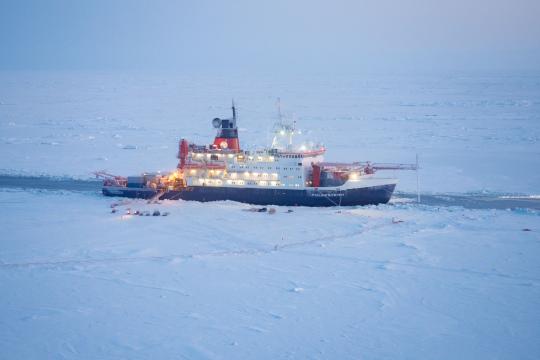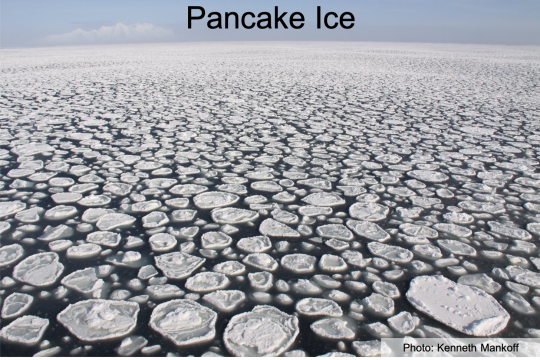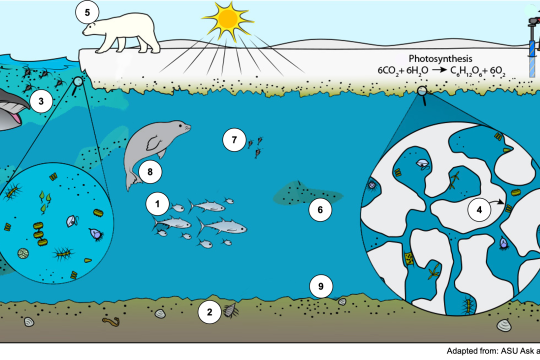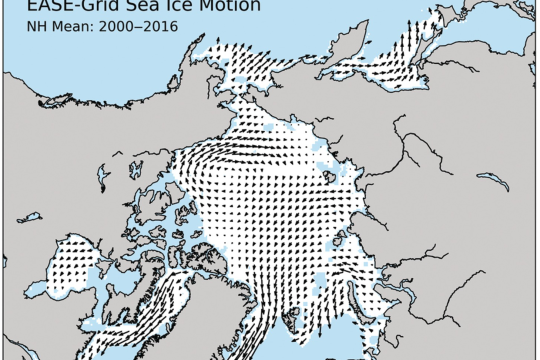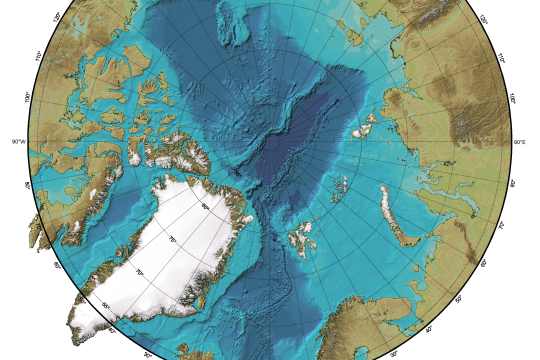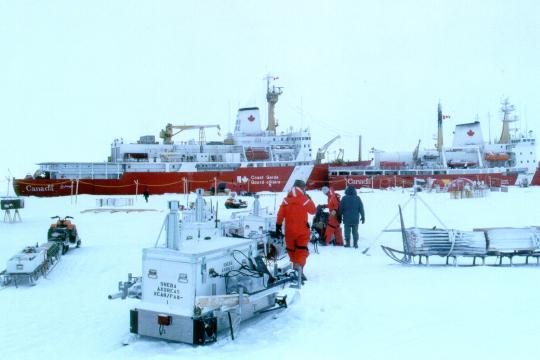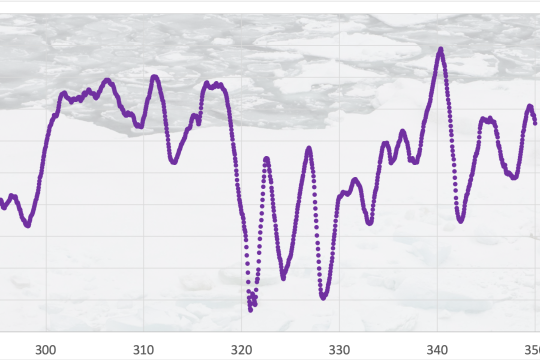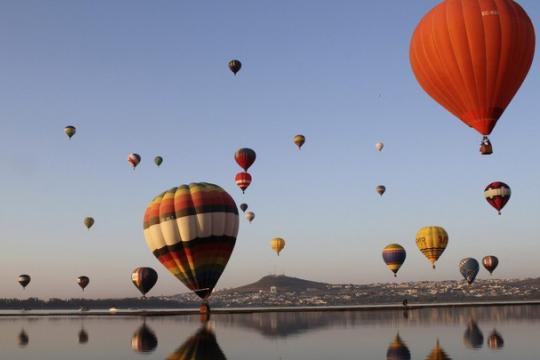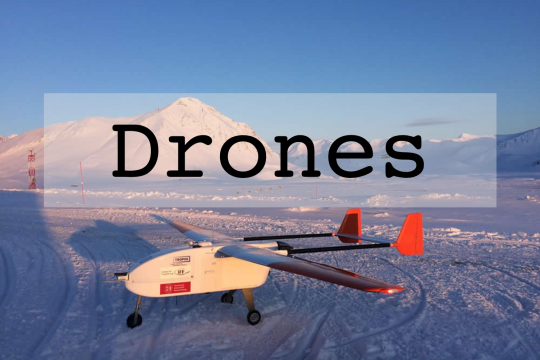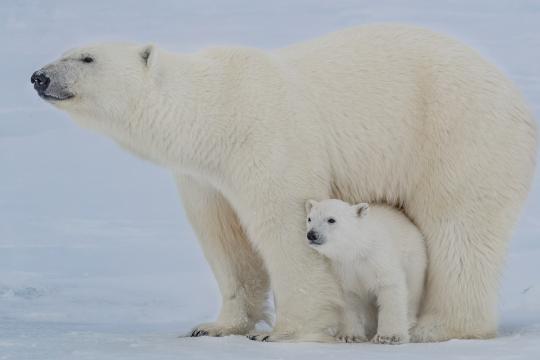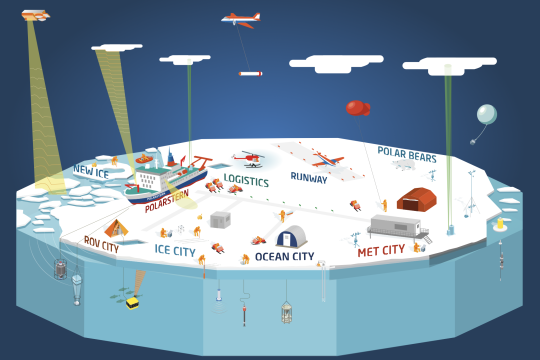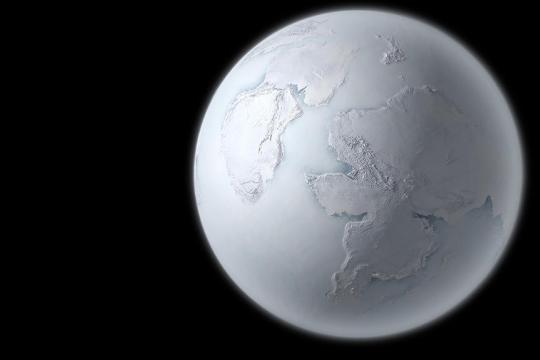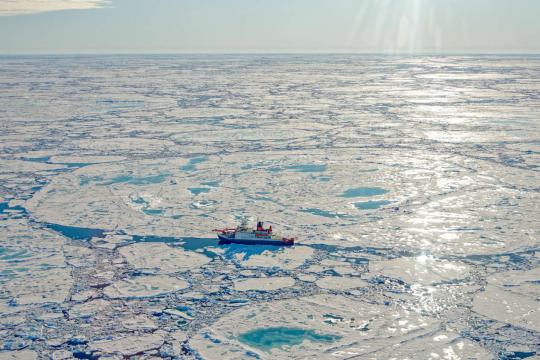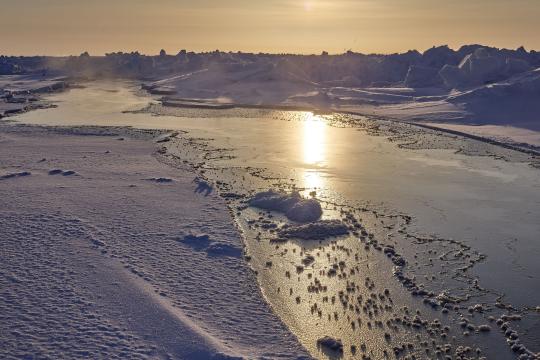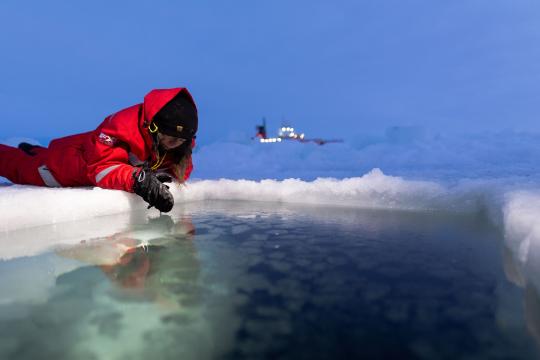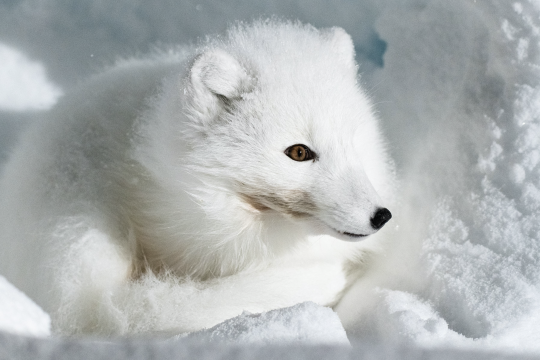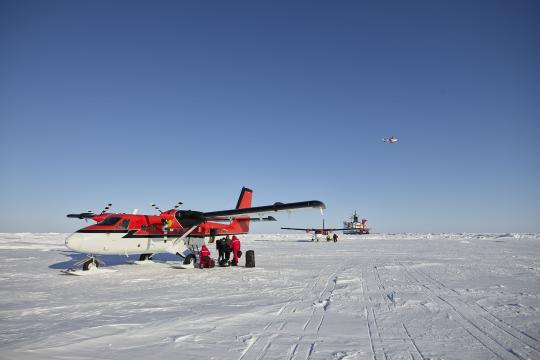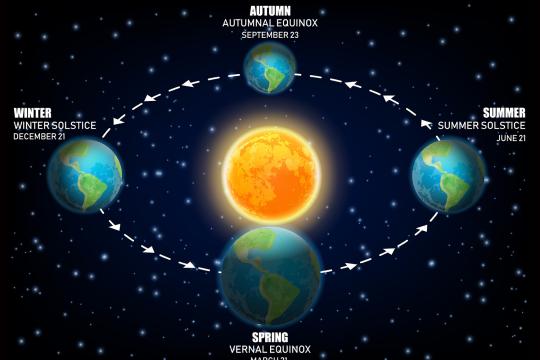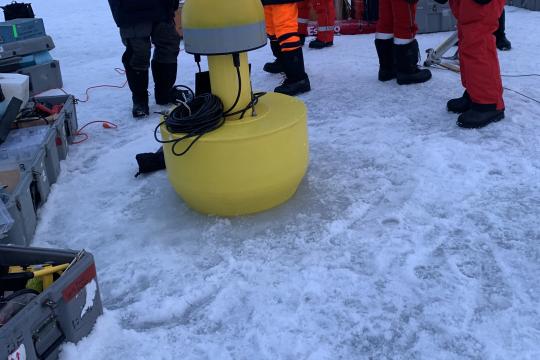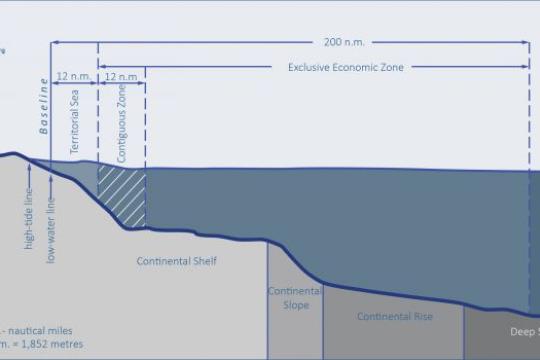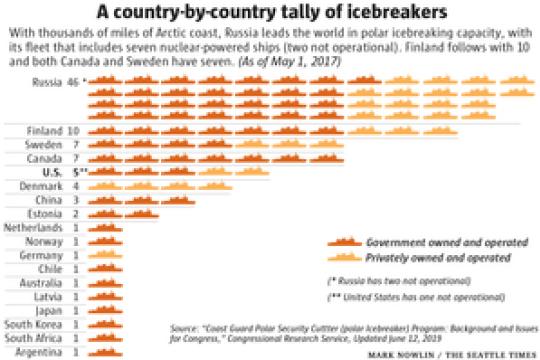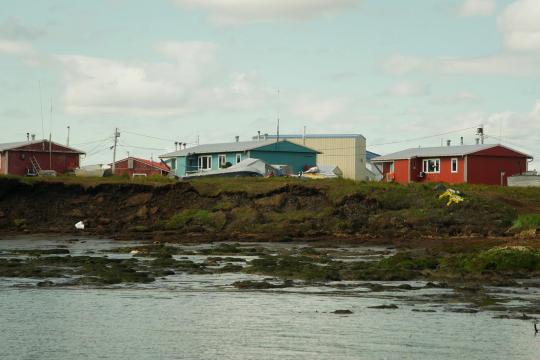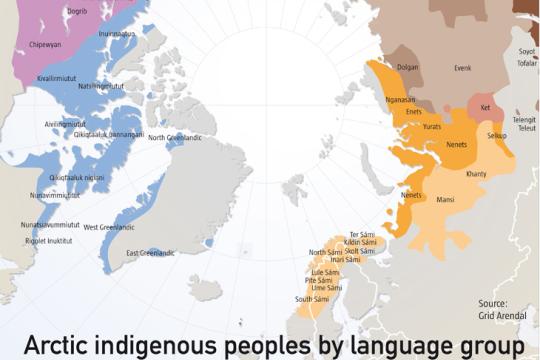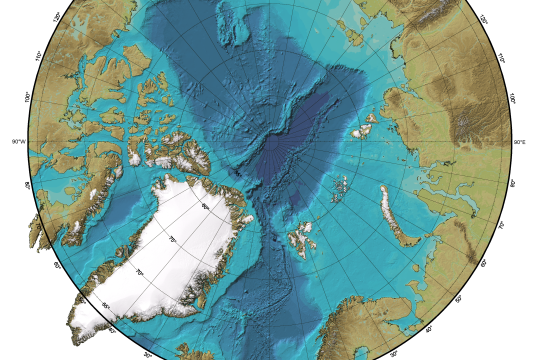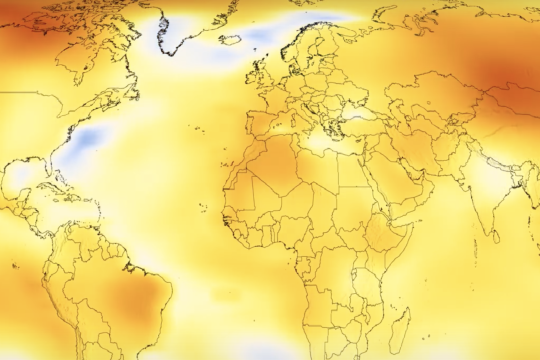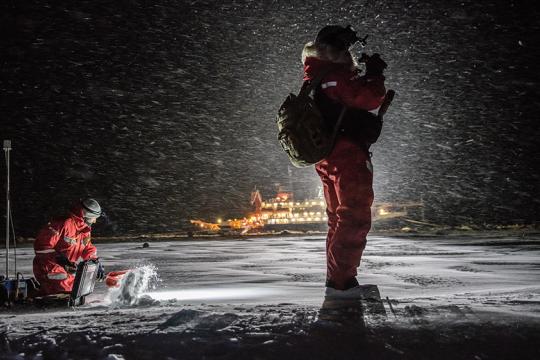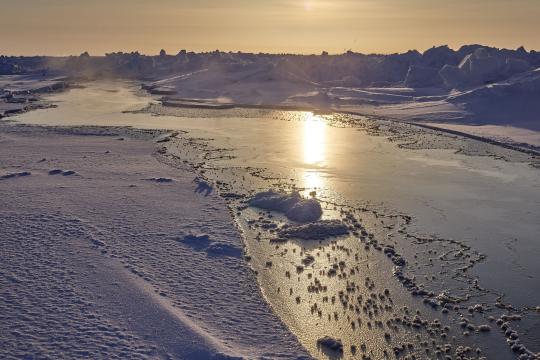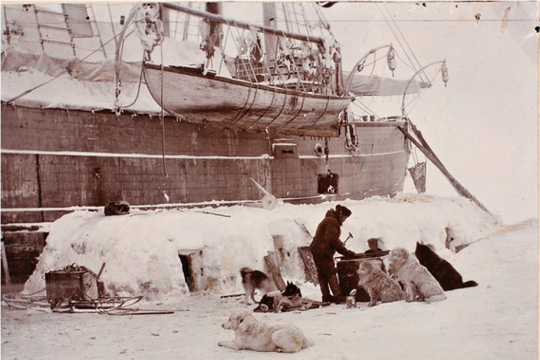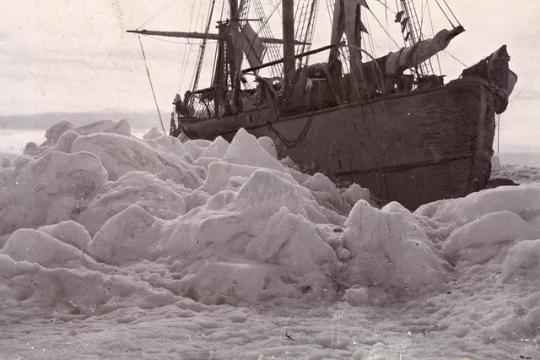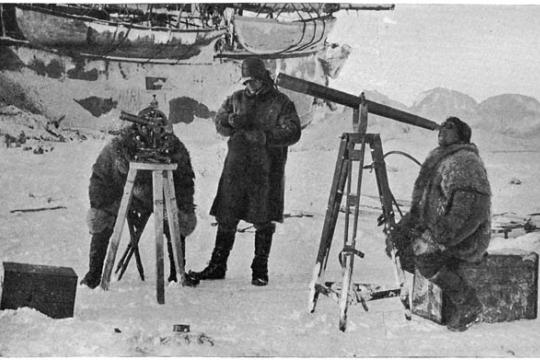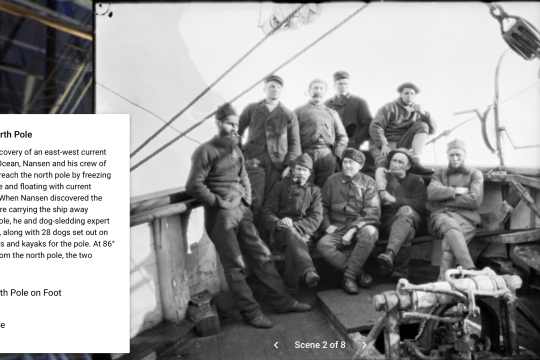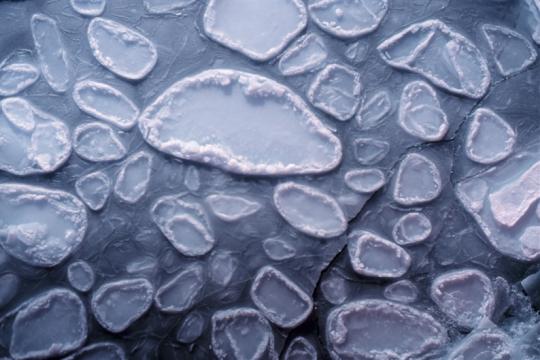mosaic monday
New Ice, New Problems
The sea ice in the Arctic is becoming newer and thinner. What kinds of impacts could this have on the Arctic region? Photo credit: Jan Rohde/AWI
Lesson plan
Subject: Expeditions, mosaic monday, Obtaining and evaluating information, Oceans and ocean circulation, Sea ice
Grade Level: Middle School, High School, University/college
Developer: CIRES
The sea ice in the Arctic is becoming newer and thinner. What kinds of impacts could this have on the Arctic region? Photo credit: Jan Rohde/AWI
Lesson plan
Subject: Expeditions, mosaic monday, Obtaining and evaluating information, Oceans and ocean circulation, Sea ice
Grade Level: Middle School, High School, University/college
Developer: CIRES
The Writing's in the Ice
Did you know that sea ice has a life cycle? Learn more in this short (~30 minute) activity.
Lesson plan
Subject: Arguing from evidence, mosaic monday, Sea ice
Grade Level: Middle School, High School
Developer: CIRES
Did you know that sea ice has a life cycle? Learn more in this short (~30 minute) activity.
Lesson plan
Subject: Arguing from evidence, mosaic monday, Sea ice
Grade Level: Middle School, High School
Developer: CIRES
Quick Bite: Fill in the Food Web
What does an Arctic food web look like, and what are the relationships between its members? Find out in this Quick Bite activity.
Quick bite
Subject: Constructing explanations, Developing and using models, Ecosystems, Life science, mosaic monday, Polar Bears
Grade Level: 3-5, Middle School, High School
Developer: CIRES
What does an Arctic food web look like, and what are the relationships between its members? Find out in this Quick Bite activity.
Quick bite
Subject: Constructing explanations, Developing and using models, Ecosystems, Life science, mosaic monday, Polar Bears
Grade Level: 3-5, Middle School, High School
Developer: CIRES
Quick Bite: Arctic Current Events
Can you identify currents in the Arctic Ocean using ocean motion vector maps? Figure credit: NASA/NSIDC/DAAC/University of Colorado Tschudi, Meier, Stewart
Quick bite
Subject: Earth science, mosaic monday, Oceans and ocean circulation
Grade Level: High School
Developer: CIRES
Can you identify currents in the Arctic Ocean using ocean motion vector maps? Figure credit: NASA/NSIDC/DAAC/University of Colorado Tschudi, Meier, Stewart
Quick bite
Subject: Earth science, mosaic monday, Oceans and ocean circulation
Grade Level: High School
Developer: CIRES
Quick Bite: The Arctic vs. the World
How does the Arctic Ocean's bathymetry compare to Earth's other ocean basins? Learn more in this Quick Bite activity.
Project of Mosaic Quick bite
Subject: Earth science, Geography, mosaic monday, Oceans and ocean circulation
Grade Level: Middle School, High School
Developer: CIRES
How does the Arctic Ocean's bathymetry compare to Earth's other ocean basins? Learn more in this Quick Bite activity.
Project of Mosaic Quick bite
Subject: Earth science, Geography, mosaic monday, Oceans and ocean circulation
Grade Level: Middle School, High School
Developer: CIRES
Quick Bite: Clouds in the Summer, Clouds in the Winter?
Is there seasonal variation in cloud cover in the Arctic? Learn more in this Quick Bite activity. Figure credit: NASA Earth Observatory
Quick bite
Subject: Analyzing and interpreting data, Atmosphere, Earth science, mosaic monday
Grade Level: Middle School, High School
Developer: CIRES
Is there seasonal variation in cloud cover in the Arctic? Learn more in this Quick Bite activity. Figure credit: NASA Earth Observatory
Quick bite
Subject: Analyzing and interpreting data, Atmosphere, Earth science, mosaic monday
Grade Level: Middle School, High School
Developer: CIRES
Quick Bite: Correlation, Causation, and Clouds
In this Quick Bite activity, students will examine actual data from the SHEBA Arctic research expedition to see if there is a correlation between surface temperature in the Arctic and cloud cover. Photo credit: Don Perovich
Project of Mosaic Quick bite
Subject: Analyzing and interpreting data, Atmosphere, Expeditions, mosaic monday
Grade Level: Middle School, High School
Developer: CIRES
In this Quick Bite activity, students will examine actual data from the SHEBA Arctic research expedition to see if there is a correlation between surface temperature in the Arctic and cloud cover. Photo credit: Don Perovich
Project of Mosaic Quick bite
Subject: Analyzing and interpreting data, Atmosphere, Expeditions, mosaic monday
Grade Level: Middle School, High School
Developer: CIRES
Quick Bite: Weathering the Storms
Scientists on the 2019-2020 MOSAiC expedition were interested in collecting air pressure data, as air pressure can give you an indication of weather changes. Can you identify changes in weather from actual air pressure data from the MOSAiC expedition?
Project of Mosaic Quick bite
Subject: Analyzing and interpreting data, Atmosphere, Expeditions, mosaic monday
Grade Level: Middle School, High School
Developer: CIRES
Scientists on the 2019-2020 MOSAiC expedition were interested in collecting air pressure data, as air pressure can give you an indication of weather changes. Can you identify changes in weather from actual air pressure data from the MOSAiC expedition?
Project of Mosaic Quick bite
Subject: Analyzing and interpreting data, Atmosphere, Expeditions, mosaic monday
Grade Level: Middle School, High School
Developer: CIRES
Quick Bite: Pondering Pressure
What is air pressure? Explore this and more using a PhET simulation in this Quick Bite activity. Photo credit: Mario Armas/Reuters
Quick bite
Subject: Constructing explanations, Developing and using models, mosaic monday, Physical science
Grade Level: Middle School, High School
Developer: CIRES
What is air pressure? Explore this and more using a PhET simulation in this Quick Bite activity. Photo credit: Mario Armas/Reuters
Quick bite
Subject: Constructing explanations, Developing and using models, mosaic monday, Physical science
Grade Level: Middle School, High School
Developer: CIRES
Quick Bite: How did MOSAiC scientists study the Arctic atmosphere?
Learn about the various instruments scientists used to study the atmosphere during the 2019-2020 MOSAiC expedition in this Quick Bite activity.
Project of Mosaic Quick bite
Subject: Atmosphere, Earth science, Engineering and technology, Expeditions, mosaic monday, Physical science
Grade Level: Middle School, High School
Developer: CIRES
Learn about the various instruments scientists used to study the atmosphere during the 2019-2020 MOSAiC expedition in this Quick Bite activity.
Project of Mosaic Quick bite
Subject: Atmosphere, Earth science, Engineering and technology, Expeditions, mosaic monday, Physical science
Grade Level: Middle School, High School
Developer: CIRES
Quick Bite: Alien Atmospheres
Do other planets in our solar system have atmospheres? If so, how to they compare to Earth's? Find out in this Quick Bite activity. Photo credit: NASA
Quick bite
Subject: Atmosphere, Earth science, mosaic monday, Obtaining and evaluating information
Grade Level: Middle School, High School
Developer: CIRES
Do other planets in our solar system have atmospheres? If so, how to they compare to Earth's? Find out in this Quick Bite activity. Photo credit: NASA
Quick bite
Subject: Atmosphere, Earth science, mosaic monday, Obtaining and evaluating information
Grade Level: Middle School, High School
Developer: CIRES
Quick Bite: Polar Bear Adaptations
How are polar bears adapted to their chilly environment? Photo credit: Lianna Nixon, CIRES/CU Boulder
Project of Mosaic Quick bite
Subject: Constructing explanations, Life science, mosaic monday, Polar Bears
Grade Level: 3-5, Middle School, High School
Developer: CIRES
How are polar bears adapted to their chilly environment? Photo credit: Lianna Nixon, CIRES/CU Boulder
Project of Mosaic Quick bite
Subject: Constructing explanations, Life science, mosaic monday, Polar Bears
Grade Level: 3-5, Middle School, High School
Developer: CIRES
Quick Bite: Climate is a System
In this Quick Bite activity, your students will explore how Earth's systems are interconnected by becoming members of the 2019-2020 MOSAiC expedition science teams.
Project of Mosaic Quick bite
Subject: Climate, Earth science, Expeditions, mosaic monday
Grade Level: Middle School, High School
Developer: CIRES
In this Quick Bite activity, your students will explore how Earth's systems are interconnected by becoming members of the 2019-2020 MOSAiC expedition science teams.
Project of Mosaic Quick bite
Subject: Climate, Earth science, Expeditions, mosaic monday
Grade Level: Middle School, High School
Developer: CIRES
Quick Bite: Melting Ice-Albedo Feedback
Sea ice extent in the Arctic is on the decline. Could the opposite of a Snowball Earth happen? Figure credit: MIKKEL JUUL JENSEN/SPL/COSMOS
Project of Mosaic Quick bite
Subject: Arguing from evidence, Climate, Earth science, mosaic monday, Sea ice
Grade Level: Middle School, High School, University/college
Developer: CIRES
Sea ice extent in the Arctic is on the decline. Could the opposite of a Snowball Earth happen? Figure credit: MIKKEL JUUL JENSEN/SPL/COSMOS
Project of Mosaic Quick bite
Subject: Arguing from evidence, Climate, Earth science, mosaic monday, Sea ice
Grade Level: Middle School, High School, University/college
Developer: CIRES
Quick Bite: Radiation Correlation?
This short activity will help your students start to connect the concept of albedo to the Arctic and Earth's climate.
Quick bite
Subject: Climate, Constructing explanations, Earth science, mosaic monday, Sea ice
Grade Level: Middle School, High School
Developer: CIRES
This short activity will help your students start to connect the concept of albedo to the Arctic and Earth's climate.
Quick bite
Subject: Climate, Constructing explanations, Earth science, mosaic monday, Sea ice
Grade Level: Middle School, High School
Developer: CIRES
Quick Bite: Albedo Comparison
How do you think the average albedo of the Arctic compares to the average albedo of the entire Earth? Photo credit: Michael Gutsche/AWI
Quick bite
Subject: Arguing from evidence, Earth science, mosaic monday
Grade Level: Middle School, High School
Developer: CIRES
How do you think the average albedo of the Arctic compares to the average albedo of the entire Earth? Photo credit: Michael Gutsche/AWI
Quick bite
Subject: Arguing from evidence, Earth science, mosaic monday
Grade Level: Middle School, High School
Developer: CIRES
Quick Bite: Budget Your Money, Budget Your Energy
Just like you and I might have a financial budget, Earth has an energy budget. In this Quick Bite activity, students will explore this energy budget and what happens if it changes. Photo credit: Stefan Hendricks/AWI
Project of Mosaic Quick bite
Subject: Atmosphere, Climate, Developing and using models, Earth science, mosaic monday
Grade Level: Middle School, High School, University/college
Developer: CIRES
Just like you and I might have a financial budget, Earth has an energy budget. In this Quick Bite activity, students will explore this energy budget and what happens if it changes. Photo credit: Stefan Hendricks/AWI
Project of Mosaic Quick bite
Subject: Atmosphere, Climate, Developing and using models, Earth science, mosaic monday
Grade Level: Middle School, High School, University/college
Developer: CIRES
Quick Bite: Earth vs. Moon
Why are the Moon and Earth so different temperature-wise if they are essentially the same distance from the Sun?
Quick bite
Subject: Atmosphere, Climate, Constructing explanations, Earth science, mosaic monday
Grade Level: 3-5, Middle School, High School
Developer: CIRES
Why are the Moon and Earth so different temperature-wise if they are essentially the same distance from the Sun?
Quick bite
Subject: Atmosphere, Climate, Constructing explanations, Earth science, mosaic monday
Grade Level: 3-5, Middle School, High School
Developer: CIRES
Quick Bite: Arctic Adaptations
Did you know that some Arctic foxes change color depending on the season? In this Quick Bite activity, your students will hypothesize why this happens and what it means for the Arctic foxes' survival. Photo credit: Michael Ginzburg
Project of Mosaic Quick bite
Subject: Constructing explanations, Ecosystems, Life science, mosaic monday
Grade Level: 3-5, Middle School, High School
Developer: CIRES
Did you know that some Arctic foxes change color depending on the season? In this Quick Bite activity, your students will hypothesize why this happens and what it means for the Arctic foxes' survival. Photo credit: Michael Ginzburg
Project of Mosaic Quick bite
Subject: Constructing explanations, Ecosystems, Life science, mosaic monday
Grade Level: 3-5, Middle School, High School
Developer: CIRES
Quick Bite: On (Thick or) Thin Ice
How thick does sea ice need to be to support an airplane landing? It turns out we can use a simple equation to calculate the answer. Photo credit: Michael Gutsche/AWI
Project of Mosaic Quick bite
Subject: Computational thinking, Expeditions, mosaic monday, Sea ice
Grade Level: Middle School, High School
Developer: CIRES
How thick does sea ice need to be to support an airplane landing? It turns out we can use a simple equation to calculate the answer. Photo credit: Michael Gutsche/AWI
Project of Mosaic Quick bite
Subject: Computational thinking, Expeditions, mosaic monday, Sea ice
Grade Level: Middle School, High School
Developer: CIRES
Quick Bite: What is the Winter Solstice?
What is the winter solstice? Construct your explanation after watching a video of the earth as it orbits the Sun.
Project of Mosaic Quick bite
Subject: Developing and using models, Earth science, mosaic monday
Grade Level: Middle School, High School
Developer: CIRES
What is the winter solstice? Construct your explanation after watching a video of the earth as it orbits the Sun.
Project of Mosaic Quick bite
Subject: Developing and using models, Earth science, mosaic monday
Grade Level: Middle School, High School
Developer: CIRES
Quick Bite: Buoy Structure and Function
In this Quick Bite activity, your students will read about SIMB buoys, watch a video of a buoy installation during the 2019-2020 MOSAiC expedition, and then discuss the structure and function of a buoy. Photo credit: Anne Gold, CIRES/CU Boulder
Project of Mosaic Quick bite
Subject: Constructing explanations, Engineering and technology, Expeditions, mosaic monday, Oceans and ocean circulation
Grade Level: Middle School, High School, University/college
Developer: CIRES
In this Quick Bite activity, your students will read about SIMB buoys, watch a video of a buoy installation during the 2019-2020 MOSAiC expedition, and then discuss the structure and function of a buoy. Photo credit: Anne Gold, CIRES/CU Boulder
Project of Mosaic Quick bite
Subject: Constructing explanations, Engineering and technology, Expeditions, mosaic monday, Oceans and ocean circulation
Grade Level: Middle School, High School, University/college
Developer: CIRES
Quick Bite: Planting a Flag in the Arctic: Not so EEZ
To claim underwater territory, coastal nations must first understand their nearshore seafloor geology. In this short activity, your students will examine maps of Arctic Ocean bathymetry and identify continental shelves of the Arctic coastal nations.
Project of Mosaic Quick bite
Subject: Earth science, Geography, Geopolitics, mosaic monday
Grade Level: Middle School, High School, University/college
Developer: CIRES
To claim underwater territory, coastal nations must first understand their nearshore seafloor geology. In this short activity, your students will examine maps of Arctic Ocean bathymetry and identify continental shelves of the Arctic coastal nations.
Project of Mosaic Quick bite
Subject: Earth science, Geography, Geopolitics, mosaic monday
Grade Level: Middle School, High School, University/college
Developer: CIRES
Quick Bite: Icebreakers of the World
Which countries in the world have icebreakers, and why? Explore these questions and more in this Quick Bite activity.
Quick bite
Subject: Engineering and technology, Expeditions, Geopolitics, mosaic monday
Grade Level: Middle School, High School
Developer: CIRES
Which countries in the world have icebreakers, and why? Explore these questions and more in this Quick Bite activity.
Quick bite
Subject: Engineering and technology, Expeditions, Geopolitics, mosaic monday
Grade Level: Middle School, High School
Developer: CIRES
Quick Bite: Climate Change Impacts on Indigenous Ways of Life
Indigenous peoples have over centuries adapted to living in the harsh and rugged Arctic, but their environment is changing rapidly. How are Indigenous peoples' ways of life being threatened by a changing climate? Photo credit: Eric Keto/Alaska's Energy Desk
Project of Mosaic Quick bite
Subject: Climate, ELA, Geography, mosaic monday
Grade Level: Middle School, High School
Developer: CIRES
Indigenous peoples have over centuries adapted to living in the harsh and rugged Arctic, but their environment is changing rapidly. How are Indigenous peoples' ways of life being threatened by a changing climate? Photo credit: Eric Keto/Alaska's Energy Desk
Project of Mosaic Quick bite
Subject: Climate, ELA, Geography, mosaic monday
Grade Level: Middle School, High School
Developer: CIRES
Quick Bite: Who Lives in the Arctic?
About 4 million people live in the Arctic, 10-12% of which are Indigenous peoples with a diversity of cultures and ways of life. In this activity, your students will learn more about who lives in the Arctic using information from maps.
Project of Mosaic Quick bite
Subject: Geography, mosaic monday, Obtaining and evaluating information
Grade Level: Middle School, High School, University/college
Developer: CIRES
About 4 million people live in the Arctic, 10-12% of which are Indigenous peoples with a diversity of cultures and ways of life. In this activity, your students will learn more about who lives in the Arctic using information from maps.
Project of Mosaic Quick bite
Subject: Geography, mosaic monday, Obtaining and evaluating information
Grade Level: Middle School, High School, University/college
Developer: CIRES
Quick Bite: Daylight to Darkness: Constructing an Explanation
Why does the amount of daylight the Arctic region gets throughout the year vary so much more than regions at lower latitudes? In this Quick Bite activity, students use an online interactive simulation to explore this question.
Project of Mosaic Quick bite
Subject: Constructing explanations, Developing and using models, Earth science, mosaic monday
Grade Level: Middle School, High School
Developer: CIRES
Why does the amount of daylight the Arctic region gets throughout the year vary so much more than regions at lower latitudes? In this Quick Bite activity, students use an online interactive simulation to explore this question.
Project of Mosaic Quick bite
Subject: Constructing explanations, Developing and using models, Earth science, mosaic monday
Grade Level: Middle School, High School
Developer: CIRES
Quick Bite: (Re)Defining the Arctic
There are several ways to define the Arctic region geographically. In this Quick Bite activity, students will explore how a changing climate could change these geographic definitions.
Project of Mosaic Quick bite
Subject: Climate, Constructing explanations, Earth science, Geography, mosaic monday
Grade Level: Middle School, High School, University/college
Developer: CIRES
There are several ways to define the Arctic region geographically. In this Quick Bite activity, students will explore how a changing climate could change these geographic definitions.
Project of Mosaic Quick bite
Subject: Climate, Constructing explanations, Earth science, Geography, mosaic monday
Grade Level: Middle School, High School, University/college
Developer: CIRES
Quick Bite: You're Getting Warmer...
Looking at how global temperatures have changed over time can give us valuable insight into our planet's health. In this Quick Bite activity, students watch an animation of global temperature anomalies over time to discover that something strange is going on in the Arctic.
Project of Mosaic Quick bite
Subject: Analyzing and interpreting data, Climate, Earth science, Geography, mosaic monday
Grade Level: Middle School, High School, University/college
Developer: CIRES
Looking at how global temperatures have changed over time can give us valuable insight into our planet's health. In this Quick Bite activity, students watch an animation of global temperature anomalies over time to discover that something strange is going on in the Arctic.
Project of Mosaic Quick bite
Subject: Analyzing and interpreting data, Climate, Earth science, Geography, mosaic monday
Grade Level: Middle School, High School, University/college
Developer: CIRES
Quick Bite: Climate in the Arctic
Why is the Arctic so much colder than the equator? What is the role of sunlight in the Arctic climate system? Explore these questions in this Quick Bite activity.
Project of Mosaic Quick bite
Subject: Asking questions, Climate, Constructing explanations, Earth science, mosaic monday
Grade Level: Middle School, High School
Developer: CIRES
Why is the Arctic so much colder than the equator? What is the role of sunlight in the Arctic climate system? Explore these questions in this Quick Bite activity.
Project of Mosaic Quick bite
Subject: Asking questions, Climate, Constructing explanations, Earth science, mosaic monday
Grade Level: Middle School, High School
Developer: CIRES
Quick Bite: What is Climate?
What is climate? In this activity, your students will explore the differences between climate and weather to try to answer this question.
Project of Mosaic Quick bite
Subject: Climate, Earth science, Geography, mosaic monday
Grade Level: Middle School, High School
Developer: CIRES
What is climate? In this activity, your students will explore the differences between climate and weather to try to answer this question.
Project of Mosaic Quick bite
Subject: Climate, Earth science, Geography, mosaic monday
Grade Level: Middle School, High School
Developer: CIRES
The Fram Expedition: Exploring the Unknown Polar Regions
Learn more about what was known and not known about the Arctic during the time of the 1893-1896 Fram expedition and what kinds of scientific observations they made during their three years locked in the ice. Check out the optional activity at the end of the reading where your students can compare the science goals of the 1893 Fram and 2019-2020 MOSAiC Arctic expeditions.
Project of Mosaic Quick bite
Subject: ELA, Expeditions, mosaic monday
Grade Level: Middle School, High School
Developer: CIRES
Learn more about what was known and not known about the Arctic during the time of the 1893-1896 Fram expedition and what kinds of scientific observations they made during their three years locked in the ice. Check out the optional activity at the end of the reading where your students can compare the science goals of the 1893 Fram and 2019-2020 MOSAiC Arctic expeditions.
Project of Mosaic Quick bite
Subject: ELA, Expeditions, mosaic monday
Grade Level: Middle School, High School
Developer: CIRES
I Notice, I Wonder: Polarstern vs. Fram
In this MOSAiC Quick Bite activity, compare the rooms inside the Fram ship from the 1893 expedition to the Arctic with the modern Polarstern.
Project of Mosaic Quick bite
Subject: Expeditions, mosaic monday
Grade Level: 3-5, Middle School, High School
Developer: CIRES
In this MOSAiC Quick Bite activity, compare the rooms inside the Fram ship from the 1893 expedition to the Arctic with the modern Polarstern.
Project of Mosaic Quick bite
Subject: Expeditions, mosaic monday
Grade Level: 3-5, Middle School, High School
Developer: CIRES
Comparing the 1893 Fram and 2019 MOSAiC Expeditions
Compare the 1893 Fram and 2019 MOSAiC expeditions by reading and comparing firsthand accounts of each.
Project of Mosaic Quick bite
Subject: ELA, Expeditions, mosaic monday
Grade Level: Middle School, High School
Developer: CIRES
Compare the 1893 Fram and 2019 MOSAiC expeditions by reading and comparing firsthand accounts of each.
Project of Mosaic Quick bite
Subject: ELA, Expeditions, mosaic monday
Grade Level: Middle School, High School
Developer: CIRES
MOSAiC Math
Can you solve these MOSAiC expedition math problems?
Project of Mosaic Quick bite
Subject: Computational thinking, Expeditions, mosaic monday
Grade Level: Middle School, High School, University/college
Developer: CIRES
Can you solve these MOSAiC expedition math problems?
Project of Mosaic Quick bite
Subject: Computational thinking, Expeditions, mosaic monday
Grade Level: Middle School, High School, University/college
Developer: CIRES
Explore the Arctic virtually Aboard the Fram
Project of Mosaic Lesson plan
Subject: Engineering and technology, Expeditions, Geography, mosaic monday
Grade Level: Middle School, High School, University/college
Developer: CIRES
Project of Mosaic Lesson plan
Subject: Engineering and technology, Expeditions, Geography, mosaic monday
Grade Level: Middle School, High School, University/college
Developer: CIRES
Timing an Arctic Expedition
The MOSAiC (Multidisciplinary Drifting Observatory for the Study of Arctic Climate) expedition officially launched on September 20, 2019 when the icebreaker Polarstern set sail from Tromsø, Norway. The Polarstern will be looking for an ice floe that it can freeze into and drift along with across the Arctic for a year. The ice must be thick enough throughout the year to support the scientists and instruments that will be on it, but close to thinner ice that is easy to drill through. Why did the MOSAiC expedition begin in September? It turns out this isn't random, but a strategically chosen departure date. Challenge your students to use the National Snow and Ice Data Center's Charctic Interactive Sea Ice Graph to come up with an answer to this question. Then, read more about this question here. Photo: M. Van Woert, NOAA
Project of Mosaic Quick bite
Subject: Constructing explanations, Earth science, Expeditions, mosaic monday, Oceans and ocean circulation, Sea ice
Grade Level: Middle School, High School, University/college, Adult
Developer: CIRES
The MOSAiC (Multidisciplinary Drifting Observatory for the Study of Arctic Climate) expedition officially launched on September 20, 2019 when the icebreaker Polarstern set sail from Tromsø, Norway. The Polarstern will be looking for an ice floe that it can freeze into and drift along with across the Arctic for a year. The ice must be thick enough throughout the year to support the scientists and instruments that will be on it, but close to thinner ice that is easy to drill through. Why did the MOSAiC expedition begin in September? It turns out this isn't random, but a strategically chosen departure date. Challenge your students to use the National Snow and Ice Data Center's Charctic Interactive Sea Ice Graph to come up with an answer to this question. Then, read more about this question here. Photo: M. Van Woert, NOAA
Project of Mosaic Quick bite
Subject: Constructing explanations, Earth science, Expeditions, mosaic monday, Oceans and ocean circulation, Sea ice
Grade Level: Middle School, High School, University/college, Adult
Developer: CIRES
